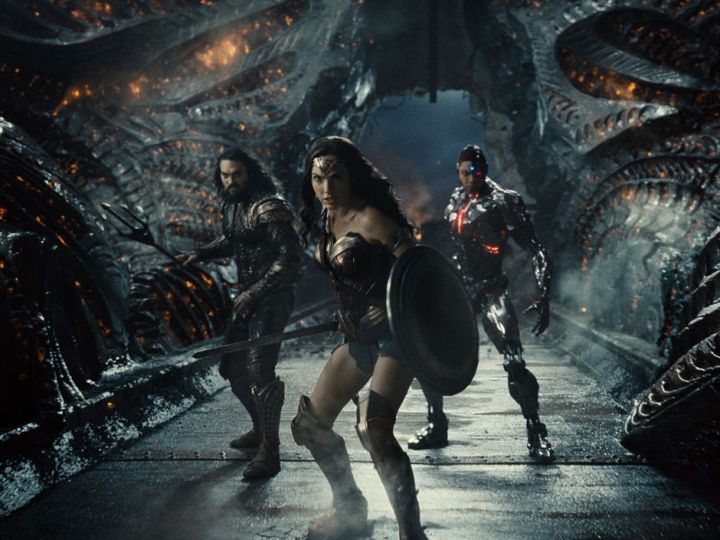Note that while this review will not spoil anything new from Zack Snyder’s Justice League, this review will cover the major plot points from the 2017 version, so if you’ve never seen that movie and are going into this one, there will be general spoilers.
After years of fans demanding Warner Brothers “release the Snyder Cut“, a version of Justice League without the reshoots done by Joss Whedon, we’re finally here. Director Zack Snyder stepped down from his duties during the original run of the movie after a family tragedy and friction with the studio, and instead of delaying the film, the studio opted to push forward to ensure their executives could keep their bonuses. The final result was a Frankenstein mash of Snyder and Whedon and was mandated to not exceed two hours long after many people thought that the theatrical cut of Batman v Superman was too bloated. But like that movie, an extended cut is now available in the form of Zack Snyder’s Justice League, a four-hour comic book epic built upon the years of fan expectations, positive campaigns and toxic fandom. And unlike Batman v Superman’s Ultimate Edition, which is a director’s cut, this version is more like the original vision, free from the shackles of theatrical runtimes and clashing directorial visions. So, after all this time and build-up, how does the actual movie fair?
Familiar, Yet Different
Presented in an old school, IMAX-worthy aspect ratio of 4:3 and slapped with an R-rating, Zack Snyder’s Justice League follows the same plot points as the 2017 version of the film, which was reshot by Joss Whedon. When the threat of great evil comes to Earth, Batman (Ben Affleck) knows that he must unite Earth’s strongest heroes under one banner to stop it. With the help of Wonder Woman (Gal Gadot), the duo seeks to form a coalition of metahumans to stop Steppenwolf (Ciarán Hinds) and his Parademons from collecting and uniting all three Mother Boxes (which would be bad for Earth). Unlike the original version, which sped us to the heroes being united in under an hour’s runtime, we only get our first introduction to Barry Allen (Ezra Miller) around 90 minutes into this version. The film, broken up into six parts and an epilogue, is in no rush to unite the team, instead of giving them plenty of time on their own to be naturally included in the movie while setting the stage for the events to come. We get a lot of time with the Amazonians, for instance, and learn that Darkseid, the big bad of the DC Universe, is behind the impending attack on Earth and while it’s fun to see the big villain created by Jack Kirby show up this time, he’s very much the Thanos to Ronan in the first Guardians of the Galaxy movie.


…And Justice For Cyborg…and Steppenwolf?
Out of all the characters and new content in the movie, the lion’s share of it belongs to Cyborg. There’s a lot of new Cyborg content in this movie. His entire backstory is fully explored here and his troubled relationship with his father, Silas Stone (Joe Morton) is realized fully this time around, as opposed to lightly implied. Cyborg is actually the heart of this movie, as Zack Snyder’s Justice League acts as an origin story for the character as well as allowing him to be a key figure in the battle against Steppenwolf, the film’s main antagonist. But while Cyborg is the key, everyone gets their moment in this movie and no one really feels like they’re tagging along for the ride. That was a huge problem with the 2017 version. After Superman joins the final battle against Steppenwolf, everyone else felt kind of useless because the Man of Steel (Henry Cavill) was just so overpowered that no one else felt necessary anymore. But this time around, even when Supes is duking it out with Steppenwolf, the rest of the team still has parts to play. It felt more like a team effort this time around. And while the black suit of Superman was more of a symbolic choice, rather than a key plot point, Henry Cavill’s brief time with the movie is much better, largely thanks to the lack of CGI lip, but also due to some brief scenes back on the Kent farm with Lois Lane and Martha Kent (Amy Adams and Diane Lane respectively)


Side-By-Side and An Uncertain Future
Part of the fun of watching this movie is trying to remember back on scenes from the original cut and figuring out which scenes belonged to Whedon and which belonged to Snyder. I’m not going to lie, there are a few scenes from the Whedon cut that I do miss, such as the “save one” and the “lasso of truth” scene with Aquaman. Other times, it’s trying to figure out if a scene was altered in the original version. When Bruce meets Aquaman for the first time, for instance, there is a handy diagram of the Mother Boxes on the wall and some obvious green-screen reshoots by the time he returns to the water. Both of those moments are gone in Snyder’s version, but he also adds to it in more ways than one.



9 thoughts on “Is ‘Zack Snyder’s Justice League’ Any Better? Review – ScreenHub Entertainment”